Stone, minerals and semiprecious of the world stone
Spar (silicates): Lazurite, Lapis lazuli -->rus
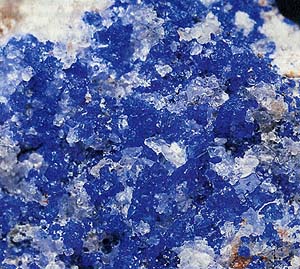 Diagnostic cart.
Diagnostic cart.
On a photo. Usually Lazurite, Lapis lazuli is presented dense the masses; but sometimes be found as shallow crystals of intensively-blue color.
(Na, Ca)8 (SO4, S, Cl)2 (Al SiO4)6
Crystal structure cube
Hardness on the Mohs scale 5,5
Specific unit weight mass 2,3-2,4
Fracture, break padman, fragile frail brittle
Colors bluish (cyan)green, light-blue
Colors in powder triturate light-blue
Glance (glitter, glare) fat

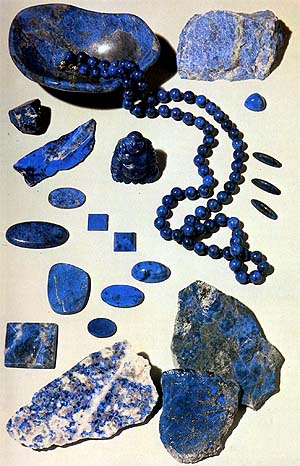 Lazurite got the name from the Arabic word "Azul" - celestially-dark blue. Under Lapis lazuli the last years usually understood not mineral, but rock in which, besides a main constituent - Lazurite, many other minerals are present also: Calcite, Diopside, micas, amphiboles, Pyrite. Therefore Lapis lazuli, strictly speaking, considering the synonym of Lazurite is not necessary.
Lazurite got the name from the Arabic word "Azul" - celestially-dark blue. Under Lapis lazuli the last years usually understood not mineral, but rock in which, besides a main constituent - Lazurite, many other minerals are present also: Calcite, Diopside, micas, amphiboles, Pyrite. Therefore Lapis lazuli, strictly speaking, considering the synonym of Lazurite is not necessary.
Usually Lazurite, Lapis lazuli (known also under the name Lapis lazuli) forms dense the masses with admixtures, fine-grained, painted in an intensive azure, sky-blue color, sometimes with a tendency to light bluish (cyan) -green. There are spots of the golden-yellow colouring, related to including of shallow granules of Pyrite. Very rarely there are opaque crystals of the octahedral forms, possessing glass brilliance.
Chemical composition (chemistry, compound). Oxide of natrium sodium (Na2O) 16,8%, kemidol (SAO) 8,7%, oxide of aluminium (Al2o3) 27,2%, silex (SiO2) 31,8%, oxide 34% is grey (SO3), chlorine (Sl) 0,25%. Form of crystals. Crystals are very rare. Crystalline structure. Simple cube structure. The ions of chlorine are disposed in corners and in a center a cube in tetrahedron surroundings of ions of natrium sodium. Class of symmetry. Geksatetraedricheskiy - 43m. Aggregates. Dense, amorphous. A rare blue mineral consisting of a sodium-calcium-aluminium silicate and sulphide: used as the gemstone lapis lazuli. Formula: (Na,Ca)8(AlSiO4)6(SO4,S,Cl)2.
Diagnostic indication.
In muriatic acid decomposes fully, selecting the sulphuretted hydrogen. In flame of candle grow pale at first, then alloyed in light-серое glass. Alloyed in white glass. A behavior is in acids. Decomposes in HCl with the selection of the sulphuretted hydrogen.
Origin provenance genesis.
In nature Lazurite, Lapis lazuli is not too widespread. His formation, presumably, is related to contact metamorphism on the border of orthorocks and limestones of the dolomitized type.
Deposit minefield mine field occurrence subsoil.
Most more ancient and the known deposit - Sary-Sang in Badakhshane, within the limits of backbone Gindukush, along a border between Tadjikistan and Russia. Other large deposits are in the district of lake Baykal in Siberia. In them Lapis lazuli is in limestone rocks and possesses more light colouring. It is necessary to mention also deposits in Chile within the limits of Andskikh of Cordilleras.
Application is on jeweller business.
Lazurite, Lapis lazuli is material, very difficult for treatment and very porous. But at a polish it acquires good brilliance. In the past it was widely used for making of entail; presently it is applied for cutting in form spheres of small size, and also cabochon and different type of the hand-made articles.
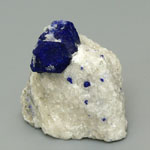
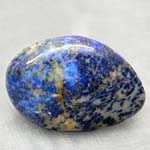
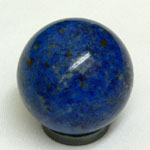
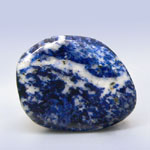
Lazurite, Lapis lazuli is unsteady against high temperatures, pressure, hot water, acids and soap. Glance (glitter, glare) glassy to fat. In Lazurite colouring is even super, more frequent than all distributed spots and bars. Quality of Lazurite from Chile and Baltic goes down large maintenance of white Calcite. Shallow inclusion Pyrite, vice versa, considered a desirable admixture - they decorate stone and at the same time prove his natural origin. But the color of stone does for surplus of sulfides, giving him an undesirable green tint.
A major deposit of Lazurite (Badakhshanskoe), by ages supplying wonderful cornflower intense-cornflower bonnie blue stone, is in the western offspurs of Gindukusha in Afghanistan, at the sources of river Amudarya. An analogical deposit is present in the CIS - on Pamire. Lazurite, Lapis lazuli there forms unevenly up-diffused inclusion in granular limestone, marble limestones. Malo-Bystrinskoe the deposit of Lazurite in the CIS is located on a south-west from lake Baykal (Russia, CIS). Here white serves as a containing rock dolomite marble. Lazurit of poor quality supplies with Chile - with large maintenance of whitish spots of Calcite. A mine deposit is located to the north of Santiago in the province of Kakimbo.
Lazurite, Lapis lazuli was used as material for decorations as early as prehistoric times. In middle ages it went also to making of light-blue-dark blue paint - ultramarine. In locks and palaces of Europe it is possible to sm walls and columns, facings Lapis lazuli. In our days from Lazurite do insertions for rings, beads, sometimes Chilean and of Lake Baikal Lazurite, Lapis lazuli is used as material for shallow the plastic arts.
Lazurite, Lapis lazuli imitate, painting the Berlin azure jasper from Nunkirkhena ("German" or "swiss silver nitrate"). In 1954 (XX century) at the market as an imitation of Lazurite the light-blue-dark blue appeared synthetic Spinel as a dense grainy aggregate, cobalt painted an oxide. Shallow spangles golds, imitating disseminations of Pyrite, strengthen the impression of naturalness of stone. Entangling Lazurite, Lapis lazuli is possible with Azurite, Dumorterite, lazurite, sodalite. There are also imitations from glass.
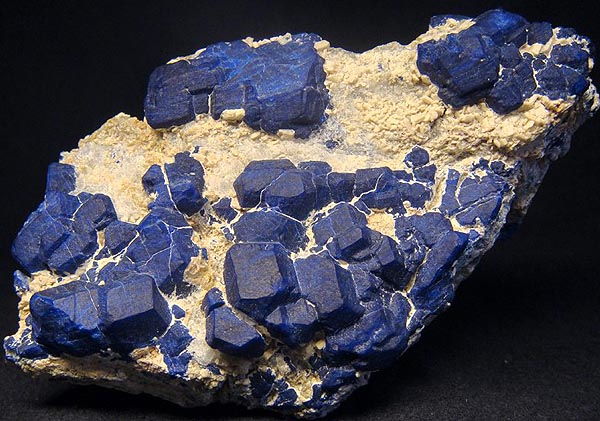
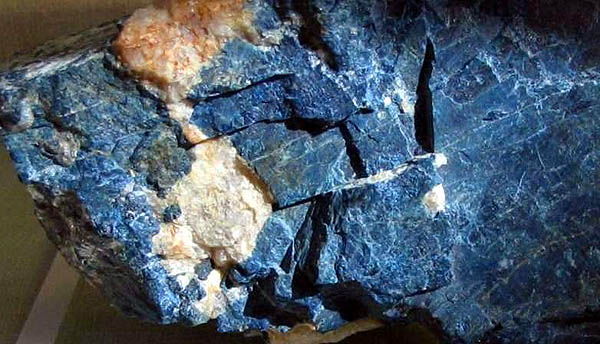
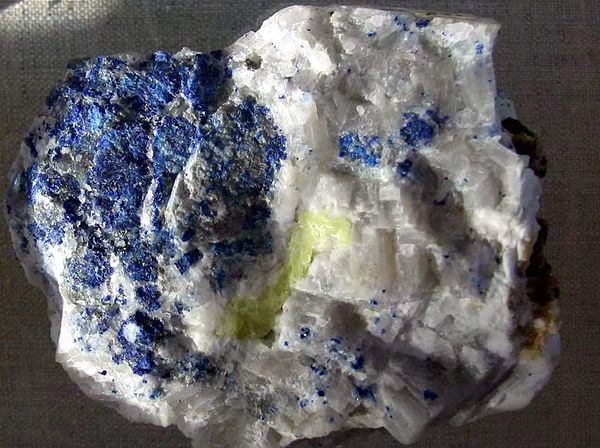
Dark blue Lazurite, Lapis lazuli with inclusions fleck of yellow sulphur (active volcanos) in a white rock. A photo: А.А. Евсеев.
